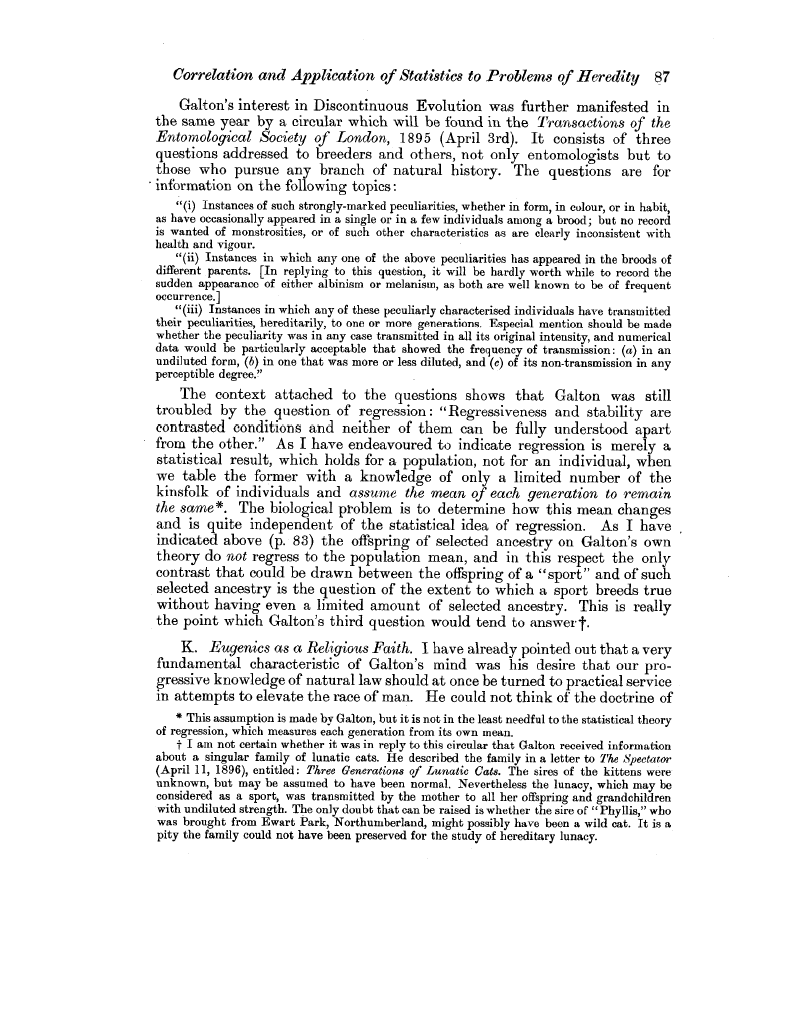| ||||||

OCR Rendition - approximate
Correlation and Application of Statistics to Problems of Heredity 87 Galton's interest in Discontinuous Evolution was further manifested in the same year by a circular which will be found in the 1 ransactions of the Entomological Society of London, 1895 (April 3rd). It consists of three questions addressed to breeders and others, not only entomologists but to those who pursue any branch of natural history. The questions are for information on the following topics "(i) Instances of such strongly-marked peculiarities, whether in form, in colour, or in habit, as have occasionally appeared in a single or in a few individuals among a brood; but no record is wanted of monstrosities, or of such other characteristics as are clearly inconsistent with health and vigour. "(ii) Instances in which any one of the above peculiarities has appeared in the broods of different parents. [In replying to this question, it will be hardly worth while to record the sudden appearance of either albinism or melanism, as both are well known to be of frequent occurrence.] "(iii) Instances in which any of these peculiarly characterised individuals have transmitted their peculiarities, hereditarily, to one or more generations. Especial mention should be made whether the peculiarity was in any case transmitted in all its original intensity, and numerical data would be particularly acceptable that showed the frequency of transmission: (a) in an undiluted form, (b) in one that was more or less diluted, and (c) of its non-transmission in any perceptible degree." The context attached to the questions shows that Galton was still troubled by the question of regression : "Regressiveness and stability are contrasted conditions and neither of them can be fully understood apart from the other." As I have endeavoured to indicate regression is merely a statistical result, which holds for a population, not for an individual, when we table the former with a knowledge of only a limited number of the kinsfolk of individuals and assume the mean of each generation to remain the same*. The biological problem is to determine how this mean changes and is quite independent of the statistical idea of regression. As I have indicated above (p. 83) the offspring of selected ancestry on Galton's own theory do not regress to the population mean, and in this respect the only contrast that could be drawn between the offspring of a "sport" and of such selected ancestry is the question of the extent to which a sport breeds true without having even a limited amount of selected ancestry. This is really the point which Galton's third question would tend to answer'. K. Eugenics as a Religious Faith. I have already pointed out that a very fundamental characteristic of Galton's mind was his desire that our progressive knowledge of natural law should at once be turned to practical service in attempts to elevate the race of man. He could not think of the doctrine of * This assumption is made by Galton, but it is not in the least needful to the statistical theory of regression, which measures each generation from its own mean. t I am not certain whether it was in reply to this circular that Galton received information about a singular family of lunatic cats. He described the family in a letter to The Spectator (April 11, 1896), entitled: Three Generations of Lunatic Cats. The sires of the kittens were unknown, but may be assumed to have been normal. Nevertheless the lunacy, which may be considered as a sport, was transmitted by the mother to all her offspring and grandchildren with undiluted strength. The only doubt that can be raised is whether the sire of "Phyllis," who was brought from Ewart Park, Northumberland, might possibly have been a wild cat. It is a pity the family could not have been preserved for the study of hereditary lunacy.
|